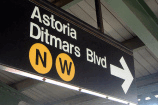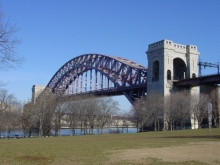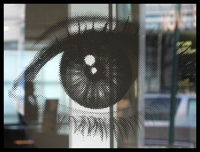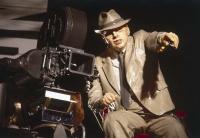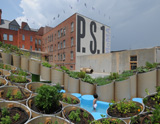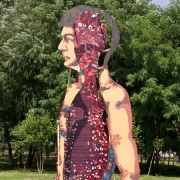| wiki | search |
Home
| Population Trends
| Gentrification
| Culinary Demography
| Architecture
Houses of Worship
| Art in Astoria
| Film Industry
| Steinway
| Index
| Contributors
Where can one find art in Astoria?
Astoria is a neighborhood in the northwestern corner of Queens in New York City. Attractions in Astoria include the Kaufman Astoria Studios' Museum of the Moving Image, Isamu Noguchi Museum, and Socrates Sculpture Park. Astoria Park, along the East River, is Astoria's largest park and also contains the largest of New York City's public pools which was also the former site of the U.S. Olympic trials. The Hell Gate Bridge and New York Connecting Railroad viaduct rise high above Astoria. The oldest beer garden in New York City, Bohemian Hall, was founded in 1910 when Astoria was largely Irish, Italian, Bohemian (Czech), and Slovak. The Greater Astoria Historical Society in the historic Quinn Memorial Building on the corner of Broadway and 36th Street serves as a valuable historical resource and it also provides tourist information. Astoria is well known for having a large Islamic district.
The architecture in Astoria is quite unlike the skyscrapers of the city. Astoria was once home to a large population of Greeks and Italians, and now sees itself expanding as a home to many other nationalities. Looking around Astoria, one sees the majority of buildings are yellow or red brick multiple family houses or apartment buildings. Walking the main streets of Astoria, it seems as if there are only stores, restaurants, and hookah bars. The signs are all colorful and streets are busy with life.
Another aspect to Astoria, Queens is its musical bit. Steinway Street is home to one of the largest piano making companies in the world, Steinway. Along this street are also many musical and dance studios where immigrants send their children to keep themselves busy and bring out the hidden talents. In many countries, knowing how to play an instrument, sing, or dance is a sign of prosperity and culture. Parents give their children to these schools at ages as young as four in hopes that maybe one day their child can perform in places like Carnegie Hall, or even just in front of a group of old family friends.
Artists, scientists, and inventors have all impacted the rich history of motion pictures and television. The museum’s purpose is to inform people of all ages about the history, art, technique and technology of film, television, and digital media. It opened in 1977 as the Astoria Motion Picture and Television Center Foundation, but later changed its name to the American Museum of the Moving Image. Now, the guest is able to watch the museum’s collection of moving-image artifacts through multimedia presentations and educational programs for students. Designed to help the viewer understand the place of film in American history and culture, the permanent Behind the Scenes exhibit explains the intricacies of producing, marketing and creating movie images. The museum has projects on the web as well. The Living Room Candidate: Presidential Campaign Commercials 1952-2008 features over 400 campaign commercials from every presidential election since 1952. Now undergoing a $65 million renovation project, the museum is going to accommodate its constantly growing amount of visitors.[1]
An elementary school is not a typical location where one would expect to find one of the oldest and largest non-profit contemporary art institutions in the United States. However, the P.S.1 contemporary art institution breaks the concept of a “traditional art institution.” In a partnership with MoMA (The Museum of Modern Art), P.S.1 displays over 50 exhibitions of contemporary art a year. The exhibits consist of “artists’ retrospectives, site-specific installations, historical surveys, arts from across the United States and the world, and a full schedule of music and performance programming.” The public school, located in Astoria, is a significant center of art for the neighborhood and Queens. The diverse residents of Astoria can experience unique and innovative artwork at P.S.1.[2]
In 1986, a group of artists, under the leadership of Mark di Suvero, turned the landfill and illegal dumpsite into an open studio for artists of the neighborhood. Now, the Socrates Sculpture Park is a prominent outdoor museum that not only allows artists to display large-scale projects in a beautiful environment, but also offers a wide range of public services, such as job training and arts education programs for people of all ages.
The park continues to expand due to contributions from people all over New York. In 2005, they received a $20 million grant from the Carnegie Corporation and New York City mayor Michael Bloomberg.[3]
Astoria: How have immigrants influenced art?
If one were to walk down Ditmars Boulevard he or she would notice the artwork and “graffiti” on the sides of many businesses. A local pharmacy has vivid images of various remedies and medications. Common themes among these murals are “patriotic images.” A mural on the side of a restaurant contained an illustration of the New York City skyline. A bar on Ditmars Boulevard displayed a mural that included a bald eagle on the background of an American flag. This artwork reinforced the concept that many business owners in Astoria are proud to display their patriotism. However, the diverse ethnic groups that inhabit the area also heavily influence the artwork in Astoria. Steinway avenue, an avenue that is occupied by Middle Eastern residents and businesses, exhibits Middle Eastern influenced artwork. Middle Eastern immigrants have brought with them the hobbies/social norms from their countries – one of them being hookah. At night, the air of Steinway Street in Astoria is filled with smoke that smells like candy and different fruits – the smoke that escapes through the windows and doors of the rising numbers of hookah cafes. Certain residents of Astoria see hookah as a social gathering, something that people get together to do after a busy workday. Hookah cafes exhibit themes of Middle Eastern architecture, and the hookahs themselves have unique designs. Many shops add to the artwork in Astoria by displaying hookahs of different shapes, designs, and colors in their storefronts.
References
- ↑ http://www.movingimage.us/site/site.php
- ↑ http://www.ps1.org/
- ↑ http://www.socratessculpturepark.org/
Home
| Population Trends
| Gentrification
| Culinary Demography
| Architecture
Houses of Worship
| Art in Astoria
| Film Industry
| Steinway
| Index
| Contributors

